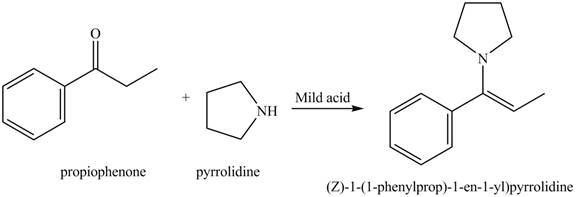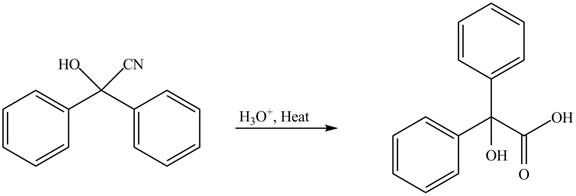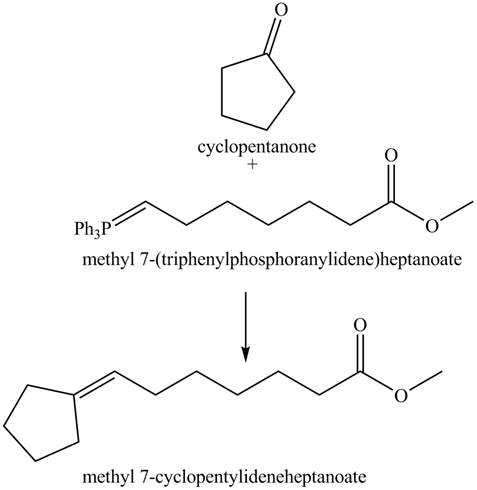
Concept explainers
Draw the products of each reaction.
a.  e.
e. 
b.  f.
f. 
c.  g.
g. 
d.  h.
h. 
(a)
Interpretation: The product of the given reaction is to be drawn.
Concept introduction: A carbonyl compound (aldehyde or ketone) reacts with
Answer to Problem 21.46P
The product of the given reaction isdrawn in Figure 1.
Explanation of Solution
The given reaction involves the treatment of an aldehyde with a
A carbonyl compound (aldehyde or ketone) reacts with
Thus, the product of the given reaction is,

Figure 1
(b)
Interpretation: The product of the given reaction is to be drawn.
Concept introduction: Acetals are the groups in which carbon atom is bonded with two
Answer to Problem 21.46P
The product of the given reaction isdrawn in Figure 2.
Explanation of Solution
The given reaction involves the treatment of a ketone with a diol.
Acetals are the groups in which carbon atom is bonded with two
Thus, the product of the given reaction is,

Figure 2
(c)
Interpretation: The product of the given reaction is to be drawn.
Concept introduction: The hydrolysis of both enamines and imines yield aldehydes or ketones. The mechanisms of both reactions are exactly opposite to their formations, as they are formed from the treatment of aldehyde/ketones with amines.
Answer to Problem 21.46P
The product of the given reaction isdrawn in Figure 3.
Explanation of Solution
The given reaction involves the hydrolysis of an imine.
The hydrolysis of both enamines and imines yield aldehydes orketones along with primary (imine) or secondary amine (enamine). The mechanisms of both reactions are exactly opposite to their formations, as they are formed from the treatment of aldehyde/ketones with amines.
Thus, the product of the given reaction is,

Figure 3
(d)
Interpretation: The product of the given reaction is to be drawn.
Concept introduction: A carbonyl compound (aldehyde or ketone) reacts with
Answer to Problem 21.46P
The product of the given reaction isdrawn in Figure 4.
Explanation of Solution
The given reaction involves the treatment of ketone with
A carbonyl compound (aldehyde or ketone) reacts with
Thus, the product of the given reaction is,

Figure 4
(e)
Interpretation: The product of the given reaction is to be drawn.
Concept introduction: Cyanohydrins are the nucleophilic addition product of carbonyl compounds in which
Answer to Problem 21.46P
The product of the given reaction isdrawn in Figure 5.
Explanation of Solution
The given reaction involves the hydrolysis of cyanohydrin compound.
Cyanohydrins are the nucleophilic addition product of carbonyl compounds in which
Thus, the product of the given reaction is,

Figure 5
(f)
Interpretation: The product of the given reaction is to be drawn.
Concept introduction: Hemiacetals are the groups in which carbon atom is bonded to one
Answer to Problem 21.46P
The product of given reaction isdrawn in Figure 6.
Explanation of Solution
The given reaction involves the treatment of cyclic hemiacetal with ethanol in the presence of acid.
Hemiacetals are the groups in which carbon atom is bonded to one
Thus, the product of the given reaction is,
<
Figure 6
(g)
Interpretation: The product of the given reaction is to be drawn.
Concept introduction: The hydrolysis of both enamines and imines yield aldehydes or ketones along with primary (imine) or secondary amine (enamine). The mechanisms of both reactions are exactly opposite to their formations, as they are formed from the treatment of aldehyde/ketones with amines.
Answer to Problem 21.46P
The product of the given reaction isdrawn in Figure 7.
Explanation of Solution
The given reaction involves the hydrolysis of an enamine.
The hydrolysis of both enamines and imines yield aldehydes or ketones along with primary (imine) or secondary amine (enamine). The mechanisms of both reactions are exactly opposite to their formations, as they are formed from the treatment of aldehyde/ketones with amines.
Thus, the Product of the given reaction is,

Figure 7
(h)
Interpretation: The product of given reaction is to be drawn.
Concept introduction: The Wittig reaction utilizes carbon nucleophile from the Wittig reagent to yield alkenes. When a carbonyl compound is treated with a Wittig reagent, the
Answer to Problem 21.46P
The product of the given reaction isdrawn in Figure 8.
Explanation of Solution
The given reaction involves the hydrolysis of an enamine.
The Wittig reaction utilizes carbon nucleophile from the Wittig reagent to yield alkenes. When a carbonyl compound is treated with a Wittig reagent, the
Thus, the product of the given reaction is,

Figure 8
(a) The product of the given reaction is drawn in Figure 1.
(b) The product of the given reaction is drawn in Figure 2.
(c) The product of the given reaction is drawn in Figure 3.
(d) The product of the given reaction is drawn in Figure 4.
(e) The product of the given reaction is drawn in Figure 5.
(f) The product of the given reaction is drawn in Figure 6.
(g) The product of the given reaction is drawn in Figure 7.
(h) The product of the given reaction is drawn in Figure 8.
Want to see more full solutions like this?
Chapter 21 Solutions
PKG ORGANIC CHEMISTRY
Additional Science Textbook Solutions
General, Organic, and Biological Chemistry - 4th edition
Brock Biology of Microorganisms (15th Edition)
Microbiology Fundamentals: A Clinical Approach
Campbell Essential Biology (7th Edition)
- K Draw the starting structure that would lead to the major product shown under the provided conditions. Drawing 1. NaNH2 2. PhCH2Br 4 57°F Sunny Q Searcharrow_forward7 Draw the starting alkyl bromide that would produce this alkyne under these conditions. F Drawing 1. NaNH2, A 2. H3O+ £ 4 Temps to rise Tomorrow Q Search H2arrow_forward7 Comment on the general features of the predicted (extremely simplified) ¹H- NMR spectrum of lycopene that is provided below. 00 6 57 PPM 3 2 1 0arrow_forward
 ChemistryChemistryISBN:9781305957404Author:Steven S. Zumdahl, Susan A. Zumdahl, Donald J. DeCostePublisher:Cengage Learning
ChemistryChemistryISBN:9781305957404Author:Steven S. Zumdahl, Susan A. Zumdahl, Donald J. DeCostePublisher:Cengage Learning ChemistryChemistryISBN:9781259911156Author:Raymond Chang Dr., Jason Overby ProfessorPublisher:McGraw-Hill Education
ChemistryChemistryISBN:9781259911156Author:Raymond Chang Dr., Jason Overby ProfessorPublisher:McGraw-Hill Education Principles of Instrumental AnalysisChemistryISBN:9781305577213Author:Douglas A. Skoog, F. James Holler, Stanley R. CrouchPublisher:Cengage Learning
Principles of Instrumental AnalysisChemistryISBN:9781305577213Author:Douglas A. Skoog, F. James Holler, Stanley R. CrouchPublisher:Cengage Learning Organic ChemistryChemistryISBN:9780078021558Author:Janice Gorzynski Smith Dr.Publisher:McGraw-Hill Education
Organic ChemistryChemistryISBN:9780078021558Author:Janice Gorzynski Smith Dr.Publisher:McGraw-Hill Education Chemistry: Principles and ReactionsChemistryISBN:9781305079373Author:William L. Masterton, Cecile N. HurleyPublisher:Cengage Learning
Chemistry: Principles and ReactionsChemistryISBN:9781305079373Author:William L. Masterton, Cecile N. HurleyPublisher:Cengage Learning Elementary Principles of Chemical Processes, Bind...ChemistryISBN:9781118431221Author:Richard M. Felder, Ronald W. Rousseau, Lisa G. BullardPublisher:WILEY
Elementary Principles of Chemical Processes, Bind...ChemistryISBN:9781118431221Author:Richard M. Felder, Ronald W. Rousseau, Lisa G. BullardPublisher:WILEY





